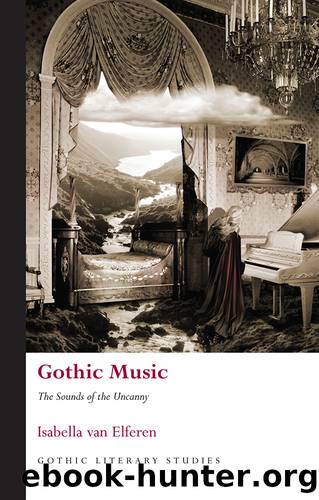Gothic Music by Elferen Isabella Van;

Author:Elferen, Isabella Van;
Language: eng
Format: epub
Publisher: University of Wales Press
Published: 2015-02-09T00:00:00+00:00
Music in Portal and Intrusion Gothic
The conflation of fantasy and horror that has become common in computer games invites an implementation of fantasy theory in the analysis of Gothic computer gaming. In her taxonomy of fantasy genres Farah Mendlesohn distinguishes, among others, portal and intrusion fantasy. Portal fantasy is âa story in which the fantasy world is reached through a gateway (such as one might find in a wardrobe)â; intrusion fantasy is âa story in which the fantastic intrudes into the mundane world; commonly found in dark fantasy and in horror.â20 These two genres of fantasy can be helpful in the analysis of video games, as the desktop computer can be considered a gateway into the game world in PC games while kinetic game consoles such as the Wii allow the game world to intrude the mundane world of the living room. The participatory Gothic of videogaming can consequently be described as portal or intrusion Gothic, depending on the type of game interface that is being used. In this situation game soundtracks have an interestingly ambivalent effect. While they partly serve to underline in-game events just like they do in film and television, the inherently spectralising force of their connotations also adds an extra layer to the virtual reality of the gaming magic circle. This musical hauntology, in turn, destabilises the already unsteady basis of the âdouble realâ.
The video game Lost (Ubisoft 2008), which was released after the third season of the television series, exemplifies the role that music can play in portal and intrusion Gothic. It is a third-person game in which the player has the role of a photojournalist who crashed on the island together with the castaways that appear in the television show. The journalist suffers from amnesia and it is the playerâs task to discover his identity and past. This plot setup allows the player to wander around the familiar island, which she can either access through the portal of her PC or which is brought into the private home through the Xbox or PlayStation consoles. The game is entirely designed as a participatory version of the television series: it is divided into episodes which start with a âpreviously on Lostâ voice-over, a cold open, the diagonal title screen, memory flashbacks revealing the playerâs past, and interviews with characters from the series (which are partly voice-acted by the official actors). To complete the picture, Giacchinoâs music accompanies cutscenes and gameplay. All the television tunes occur: the timpani rolls from the end credits and the suspenseful cello tremolos underscoring television dialogue now function as cinematic gameplay characterisation; the disembodied sighs and white noises are now a Gothic Positioning System indicating the presence of the smoke monster; and the long glissandos now reach out to the player herself, involving her actively in the islandâs mysteries. The fact that the well-known music accompanies and guides the playerâs own movements adds tremendously to her game immersion. The effect is similar to that of the soundtrack of Ghost Hunters analysed in chapter 3.
Download
This site does not store any files on its server. We only index and link to content provided by other sites. Please contact the content providers to delete copyright contents if any and email us, we'll remove relevant links or contents immediately.
4 3 2 1: A Novel by Paul Auster(11788)
The handmaid's tale by Margaret Atwood(7447)
Giovanni's Room by James Baldwin(6808)
Asking the Right Questions: A Guide to Critical Thinking by M. Neil Browne & Stuart M. Keeley(5355)
Big Magic: Creative Living Beyond Fear by Elizabeth Gilbert(5351)
Ego Is the Enemy by Ryan Holiday(4956)
On Writing A Memoir of the Craft by Stephen King(4662)
The Body: A Guide for Occupants by Bill Bryson(4581)
Ken Follett - World without end by Ken Follett(4443)
Bluets by Maggie Nelson(4261)
Adulting by Kelly Williams Brown(4232)
Eat That Frog! by Brian Tracy(4149)
Guilty Pleasures by Laurell K Hamilton(4116)
White Noise - A Novel by Don DeLillo(3829)
The Poetry of Pablo Neruda by Pablo Neruda(3814)
Fingerprints of the Gods by Graham Hancock(3736)
Alive: The Story of the Andes Survivors by Piers Paul Read(3730)
The Book of Joy by Dalai Lama(3697)
The Bookshop by Penelope Fitzgerald(3619)
